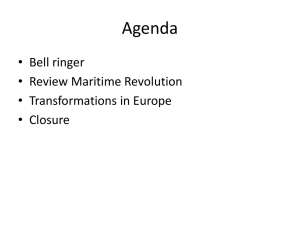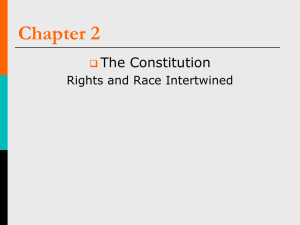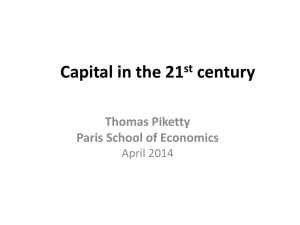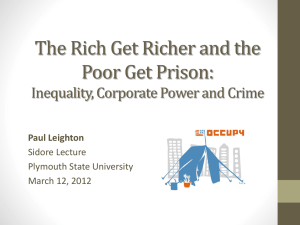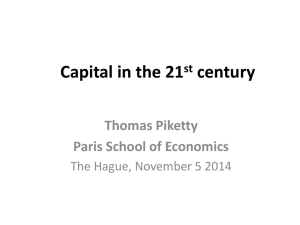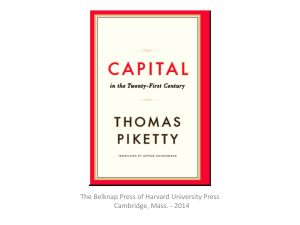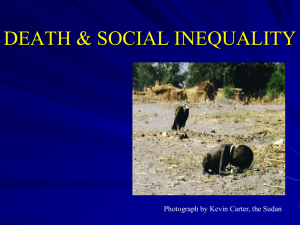2_Causes of Inequality - eduBuzz.org Learning Network
advertisement
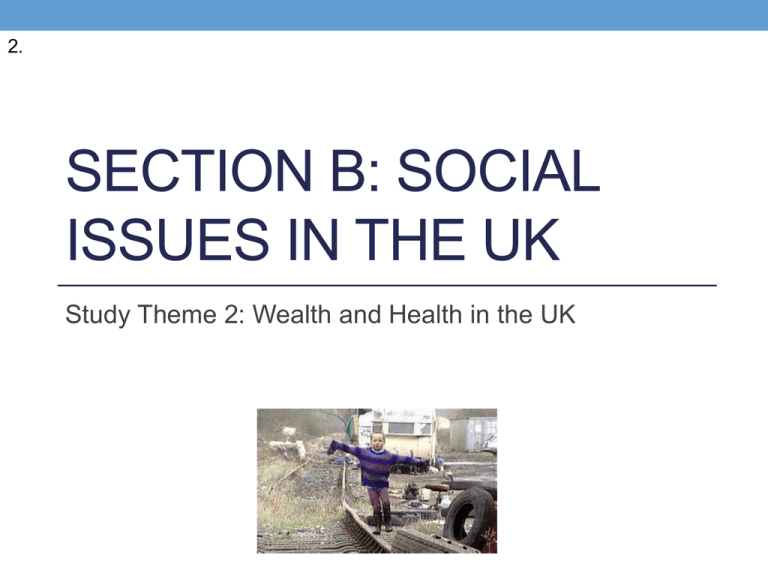
2. SECTION B: SOCIAL ISSUES IN THE UK Study Theme 2: Wealth and Health in the UK Learning Intentions • Be able to explain what social class is and how it is measured • Be able to draw a conclusion about the increasing or • • • • decreasing levels of poverty Be able to explain how wealth is measured and give examples Be able to give specific explanations and examples that show what causes poverty Give evidence to demonstrate wealth distribution in Scotland Start to think about the impact of wealth inequality CONNECT: List –O-Mania e.g. List as many... Facts about poverty in the UK as you can. NO CHEATING AND CHECKING YOUR NOTES! Despite the establishment of the Welfare State in the UK there is evidence of continuing inequalities in health and wealth. Before we investigate this fact we need to understand what social class is and how it is measured. The Registrar-General's Model of Social Class SOCIAL CLASS EXAMPLE OCCUPATIONS A Professional occupations Accountant, doctor, university teacher B Intermediate occupations Pilot, farmer, manager, police officer, teacher C1 Non-manual skilled occupations Clerical, sales representative, shop assistant, secretary C2 Manual skilled occupations Butcher, bus driver, electrician, miner D Partly skilled occupations Bus conductor, bar person, postal worker E Unskilled Occupations Labourer, cleaner office clergyman, cleaner, Middle Class Lower Class window This method divides the population by occupation however, it misses out large sections of the population. Can you spot which groups are missing? The Hope-Goldthorpe Scale SOCIAL CLASS EXAMPLE OCCUPATIONS 1 Higher grade professional Company director, senior manager Service Class 2 Lower grade administrator professional or Manager in a small business, higher level supervisor 3 Routine non-manual Clerical, sales 4 Small proprietor/self employed Small farmer, electrician, plumber 5 Lower grade technician or supervisor Lower level workers 6 Skilled manual Electrician or butcher supervisor of Intermediate Class manual Lower Class 7 Semi-skilled manual Farm labourer This method uses occupation to measure class but also tries to take into consideration management responsibilities. How are these two methods of measurement different? Which do you think is more accurate? Measuring wealth: The term wealth can be used to describe the situation of an individual or a country. Individual wealth is a monetary measure of the assets a person owns, such as; property, savings or pension rights. In the UK there is considerable inequality in individual wealth. WHO ARE THE VERY RICH? • Male: 90% • Middle-aged: 80% • Live in London/SE: 70% • Work in finance, property, accountancy, law: 60% • Average income: £785,000 The Richest Person in Britain The most affluent family in Britain, headed by Major General Gerald Grosvenor, owns 77 hectares (190 acres) of prime real estate in Belgravia, London, and has been a beneficiary of the foreign money flooding in to the capital's soaring property market in recent years. Oxfam said Grosvenor and his family had more wealth (£7.9bn) than the poorest 10% of the UK population (£7.8bn). SCOTLAND: The top 1 per cent – made up of 25,000 people earning more than £120,000 a year – are estimated to earn a tenth of all income in Scotland, and 20 times more than those in the bottom 1 per cent, according to a study published today. Draw and label and caricature to demonstrate who the VERY rich are. Inequality Video Inequality • New poverty and wealth maps of Britain reveal inequality to be at 40-year high. • Households in already-wealthy areas have tended to become disproportionately wealthier and that many rich people live in areas segregated from the rest of society. • At the same time, more households have become poor over the last 15 years, but fewer are very poor. • Danny Dorling, who led the research, said: “Most interesting and certainly unexpected when this work began is the geography of those households who are neither rich nor poor. Over time it has become clear that there is less and less room in the south for them; they have either moved elsewhere, or become poor.” Poverty Maps "Since 2003 the majority of the British public (95%) have seen a 12% real terms drop in their disposable income after housing costs, while the richest 5% of the population have seen their disposable income increase." What do the poverty maps demonstrate about wealth in Britain? JRF - Orton and Rowlingson • Over the last 20 years, a large majority of people have considered the gap between high and low incomes too large. • However, people are more likely to think that those on higher incomes are overpaid, than to believe that those on low incomes are underpaid. • While the public believe economic inequality is a problem, there is no clear agreement about how this problem should be tackled. What conclusions can you draw about inequality from this article? What does the public agree on? Why does the government find it difficult to deal with this problem? Where we are… • We have looked at evidence of wealth inequality in the UK • We have looked at where this wealth inequality is Where we are going . . . • We need to look at causes of wealth inequality • We need to look at attempts to reduce wealth inequality • We need to assess the success of these attempts • And look at the impact of continuing wealth inequality CAUSES OF INEQUALITY in wealth: *Government Policy *North/South Divide Government Policy: This section is large and is divided into sections – • Economic Policy • Taxation Policy • Employment Law • Benefits Policy Economic Policies • The government can take actions to stimulate the economy in order to reduce unemployment and reduce poverty or they can make decisions which will increase them. These economic policies will also lead to changes in interest rates and this will make lending from banks and building societies more expensive or less expensive which will then increase or reduce poverty. • The coalition government’s focus has been on austerity and reducing the national debt which they believed would restore confidence of the business sector and stimulate the economy. • National Minimum wage £7.45 per hour. Taxation Policy • Personal allowance has been increased to £10,000. From this April 2014, workers will see a small increase in their take home pay as a result of changes to personal allowances, although it will be unlikely to be enough to make up for the increases in household bills. • A couple earning £20,000 and £18,000 respectively will see their joint tax and National Insurance bills fall by around £270 a year as a result of the tax changes that come into force next month. • Changes to controlled foreign companies (CFC) rules which came into effect in 2013, have encouraged large global companies to move their head quarters to UK. The new rules mean only UKgenerated income is taxed here, with a charge only arising on the proportion of overseas profits that are “artificially diverted” from the UK. The hope being that this will create jobs. • The 50p top tax rate was scrapped in 2012. Employment Law • The Labour Government introduced Minimum Wage (£7.45 per hour) which has helped raise income levels. • Women and ethnic minorities have been helped by equal rights and discrimination legislation (Equality Act 2010). • TV's fairy Jobmother Hayley Taylor said the unemployed "need carrots, not sticks" to help them into the job market as she examined policy, as unemployment and inflation rise to levels not seen for years. • Jobseekers risk losing benefits if they turn down certain zero-hours contracts without good reason, the government has said Fairy Jobmother Interview What were the ‘sticks’ that Fairy jobmother was talking about? Benefits Policy • Cap on benefits to ensure that it is more worthwhile to be working than on benefits. Households on working age benefits can no longer receive more in benefits than the average wage for working families. • Universal Credit will replace many previous benefits. • Personal Independence Payment (PIP) from 8 April 2013 that will eventually replace DLA for people aged 16 to 64. • Employment and Support Allowance (ESA) replaced a range of incapacity benefits in 2008 for customers making a new claim because of illness or incapacity. The North/South Divide • Researchers at Cambridge University have found the wealth • • • • gap between the South East and the rest of Britain is greater now than at any other time since the Second World War. IPPR has warned the North of England was being hit hard by long-term joblessness. Youth unemployment in Bradford is double the UK average. The city is the third most affordable place in Britain to buy a home. Incomes per head in inner London are the highest in the European Union; those in Bradford are lower than the average of the UK and the EU, which includes the still extremely poor nations of the old communist bloc. Average household incomes in London and the South East are 25 per cent above those in the North. Boys born in Kensington (London) today 'will live 13.5 years longer than those in Glasgow' North/ South Divide • Average household wealth in the south-east of England is almost twice that in Scotland, according to the Office for National Statistic's first "wealth in Great Britain" report. • The theory held by some that the north-south divide was slowly fading is false. By far the wealthiest area in 200608 was the south-east of England, with median household wealth of £287,900, while Scotland was the worst off, with a median of £150,600. • Scotland was closely followed by the north-east and the north-west, which had a median household wealth of £169,500 and £168,200 respectively. Causes of Wealth Inequality: • The rapidly rising incomes of the richest 10% of the population are the major factor contributing to growing inequality in Britain. • According to the Institute for Fiscal Studies (IFS), an independent think tank, the incomes of the top 10% have risen faster than those of the population as a whole since Labour was in power in 1997. • And that increase has been particularly concentrated at the very top of the income distribution - among the half million individuals in the top 1% of the income scale. Reflect • Create and complete the following grid. • Colour code the factors to demonstrate how significant you think they are. Red being very, Amber slightly, Green very little. Causes of Inequality Government Policies: *Economic Policies Examples Impact Create changes in Leave space to complete interest rates and this this after the next lesson makes lending from cycle. banks more, or less expensive, which will then increase or reduce poverty. • Think about why you have classes the factor in the way that you did.


